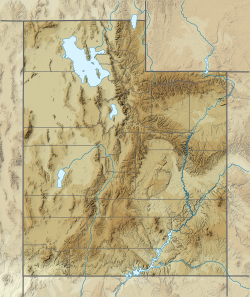| Mount Mellenthin | |
|---|---|
 West aspect | |
| Highest point | |
| Elevation | 12,645 ft (3,854 m) [1] |
| Prominence | 645 ft (197 m) [1] |
| Parent peak | Mount Peale (12,721 ft) [2] |
| Isolation | 1.75 mi (2.82 km) [2] |
| Coordinates | 38°27′47″N109°14′02″W / 38.4631295°N 109.2338845°W [3] |
| Naming | |
| Etymology | Rudolf E. Mellenthin |
| Geography | |
| Country | United States |
| State | Utah |
| County | San Juan |
| Parent range | La Sal Mountains |
| Topo map | USGS Mount Peale |
| Geology | |
| Rock age | Oligocene |
| Mountain type | Laccolith |
| Climbing | |
| Easiest route | class 2 [2] |
Mount Mellenthin is a 12,645-foot (3,854 meter) elevation summit located in San Juan County of Utah, United States. [3] Mount Mellenthin is the second-highest peak of the La Sal Mountains, and second-highest in the county. [2] It is situated in a dry, rugged, sparsely settled region, and set on land administered by Manti-La Sal National Forest. Precipitation runoff from this mountain drains into tributaries of the Colorado River. The nearest town is Moab, 20 mi (32 km) to the northwest, and the nearest higher neighbor is Mount Peale, 1.7 mi (2.7 km) to the south. The mountain's name honors Rudolf E. Mellenthin (1884–1918), forest ranger of La Sal National Forest, who was shot to death near this peak on August 23, 1918, while attempting to apprehend two draft evaders. [3] This geographical feature's toponym was officially adopted in 1932 by the U.S. Board on Geographic Names. [3]






